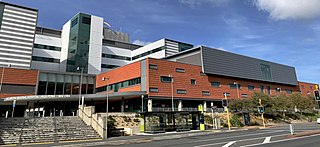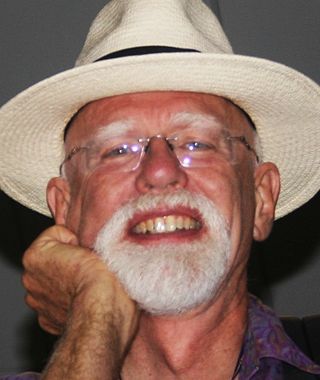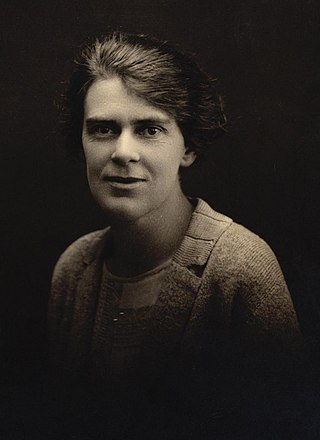Related Research Articles

A registered nurse (RN) is a nurse who has graduated or successfully passed a nursing program from a recognized nursing school and met the requirements outlined by a country, state, province or similar government-authorized licensing body to obtain a nursing license. An RN's scope of practice is determined by legislation, and is regulated by a professional body or council.

The nursing process is a modified scientific method which is a fundamental part of nursing practices in many countries around the world. Nursing practise was first described as a four-stage nursing process by Ida Jean Orlando in 1958. It should not be confused with nursing theories or health informatics. The diagnosis phase was added later.

Lieutenant Colonel Vivian Statham, was an Australian Army nurse during the Second World War. She was the sole surviving nurse of the Bangka Island Massacre, when the Japanese killed 21 of her fellow nurses on Radji Beach, Bangka Island, in the Dutch East Indies on 16 February 1942.
The New Zealand Nurses Organisation (NZNO) is New Zealand's largest trade union and professional organisation that represents the nursing profession, midwives and caregivers.

In medicine, Fowler's position is a standard patient position in which the patient is seated in a semi-sitting position and may have knees either bent or straight. Variations in the angle are denoted by high Fowler, indicating an upright position at approximately 90 degrees and semi-Fowler, 30 to 45 degrees; and low Fowler, where the head is slightly elevated." It is an intervention used to promote oxygenation via maximum chest expansion and is implemented during events of respiratory distress. Fowler's position facilitates the relaxing of tension of the abdominal muscles, allowing for improved breathing. In immobile patients and infants, the Fowler's position alleviates compression of the chest that occurs due to gravity. Fowler's position increases comfort during eating and other activities, is used in postpartum women to improve uterine drainage, and in infants when signs of respiratory distress are present. Fowler's position is also used when oral or nasal gastric feeding tubes have been implemented as it minimizes the risk of aspiration. Peristalsis and swallowing are aided by the effect of gravitational pull.

Nursing in Australia is a health care profession. Nurses and midwives form the majority (54%) of Australian health care professionals. Nurses are either registered or enrolled. Registered nurses have broader and deeper education than enrolled nurses. Nurse practitioners complete a yet higher qualification. Nurses are not limited to working in hospitals, instead working in a variety of settings. Australian nurses are in demand as traveling nurses, particularly those with advanced qualifications.

Wellington Hospital, also known as Wellington Regional Hospital, is the main hospital in Wellington, New Zealand, located south of the city centre in the suburb of Newtown. It is the main hospital run by Te Whatu Ora, Capital, Coast and Hutt Valley.

John W. Travis is an American author and medical practitioner. He is a proponent of the alternative medicine concept of "wellness", originally proposed in 1961 by Halbert L. Dunn, and has written books on the subject. In the 1970s, Travis founded the first "wellness center" in California. He originated the Illness–Wellness Continuum.
The word "nurse" originally came from the Latin word "nutrire", meaning to suckle, referring to a wet-nurse; only in the late 16th century did it attain its modern meaning of a person who cares for the infirm.

Nursing is a health care profession that "integrates the art and science of caring and focuses on the protection, promotion, and optimization of health and human functioning; prevention of illness and injury; facilitation of healing; and alleviation of suffering through compassionate presence". Nurses practice in many specialties with varying levels of certification and responsibility. Nurses comprise the largest component of most healthcare environments. Shortages of qualified nurses are found in many countries.

Dame Margaret Clara Bazley is a New Zealand public servant. She began her career as a psychiatric nurse and rose through the ranks to senior leadership positions at psychiatric hospitals and district health boards. In 1978 she became the Director of Nursing at the Department of Health, the chief nursing position in New Zealand and at that time the most senior position in the public service held by a woman, and in 1984 became the first female State Services Commissioner. She subsequently held top positions at the Department of Transport and the Department of Social Welfare.
Nursing in New Zealand is a specialist career with advanced educational requirements. Since the 19th century, the profession has evolved from on-the-job training in hospitals to a degree-level profession studied in technical institutes and universities. Due to New Zealand's geographic and geopolitical position, the country's nursing profession is both the subject of brain drain to larger nations and the recipient of brain drain from others.
Harold Bertram Turbott was a New Zealand medical doctor, public health administrator, broadcaster and writer. For four decades he broadcast a weekly talk on health on the radio.

Hester Maclean, was an Australian-born nurse, hospital matron, nursing administrator, editor and writer who spent most of her career in New Zealand. She served in the First World War as the founding Matron-in-Chief of the New Zealand Army Nursing Service, and was one of the first nurses to be awarded the Florence Nightingale Medal.

Mary Isabel Lambie was a New Zealand nurse and nursing educator. After World War II she became an international advocate for nursing and nursing education, eventually working with the World Health Organization.
Flora Jean Cameron was a New Zealand nurse, nursing instructor and administrator.
The New Zealand Army Nursing Service (NZANS) formally came into being in early 1915, when the Army Council in London accepted an offer of nurses to help in the war effort during the First World War from the New Zealand Government. The heavy losses experienced in the Gallipoli campaign cemented the need for the service.

Annette Diana Huntington is a New Zealand nursing academic. She is a professor of nursing and head of school at Massey University and previously served as chair of the Nursing Council of New Zealand.
Debra Elizabeth Jackson is an Australian academic nurse and professor of nursing at the Susan Wakil School of Nursing at the University of Sydney, Australia. In 2021 she was awarded professor emerita in the faculty of health in the University of Technology Sydney. She holds a number of adjunct roles including honorary professor of nursing, Oxford Health NHS Foundation Trust, visiting professor at the Florence Nightingale Faculty of Nursing and Midwifery in King's College London, Bournemouth University, and Auckland University of Technology. She was previously the editor-in-chief of the Journal of Clinical Nursing and is now the editor-in-chief of the Journal of Advanced Nursing.
References
- 1 2 3 4 5 6 7 8 9 10 11 12 13 14 Crisp & Taylor, 2009
- ↑ Crisp & Taylor (2009) Fundamentals of Nursing, Milestones in Nursing History: Elsevier, Australia. (3rd Ed., Ch, 1, pp 4.) Pub. Houstan, L.
- ↑ Crisp, J., & Taylor, C. (2009). Fundamentals of nursing (3rd ed., p.4), Chatswood, Australia: Elsevier Australia
- ↑ during the period 1860 to 1883. In N.Chick & J.Rodgers (Eds.) Looking back, moving forward: Essays in the history of New Zealand nursing and midwifery (pp. 5–16).
- ↑ (Potter and Perry's fundamentals of nursing. Crisp & Taylor, 2009, page 4
- ↑ (MacDonald,1990)
- ↑ Daly, J. Jackson, D. Speedy, S. (2010). Contexts of nursing (3rd ed.). Chatswood, NSW 2067. Australia. Cecotti,L.
- ↑ Lyon, E. E. (May 1977). "Short history of PHWS (Private Hospital, Wakefield Street)". The Australasian Nurses Journal. 6 (10): 18. ISSN 0301-018X. PMID 329829.
- ↑ Dock, Short History, p 268
- ↑ Sue Light. "British Military Nurses – Scarlet Finders". scarletfinders.co.uk.
- ↑ "Fairfield Infectious Diseases Hospital (previously known as Queen's Memorial Hospital/Fever Hospital 1890–1918; Queen's Memorial Infectious Diseases Hospital 1919–1947; Fairfield Hospital 1948–1969; Fairfield Infectious Diseases Hospital (1970–1996)". Public Record Office Victoria Collection – PROV. Retrieved 29 May 2024.
- ↑ "Māori nurses – Women's health – Te Ara Encyclopedia of New Zealand". teara.govt.nz.
- ↑ "History of Nursing in New Zealand". Health Times.
- ↑ Wood, P.J. (2008). "Professional, practice and political issues in the history of New Zealand's remote rural 'backblocks' nursing: The case of Mokau, 1910–1940". Contemporary Nurse: A Journal for the Australian Nursing Profession. 30 (2): 168–178. doi:10.5172/conu.673.30.2.168. PMID 19040383. S2CID 31765864.
- ↑ Dow, D. (2009). Remembering the unsung heroines. New Zealand Doctor, 36.
- ↑ O'Neill, Teresa M. (2015). "A Vision for the Bush: The NSW Bush Nursing Association 1911–1974". Nursing History Review. Retrieved 29 May 2024– via ProQuest.
- ↑ "Sister Alice Gordon Elliott nee King (1886 - 1977)". Libraries Tasmania. Retrieved 25 September 2023.
- ↑ Crisp, Taylor, Douglas & Rebeiro, 2013
- ↑ "Archived copy". Archived from the original on 10 February 2013. Retrieved 19 July 2012.
{{cite web}}: CS1 maint: archived copy as title (link) - ↑ Smith, Russell G. (1999). In Pursuit of Nursing Excellence. A History of the Royal College of Nursing, Australia 1949–99. Various libraries: Oxford University Press. ISBN 0-19-551051-8.
- ↑ Adlam, K; Dotchin, M.; Hayward, S. (2009). "Nursing first year of practice, past, present and future: documenting the journey in New Zealand". Journal of Nursing Management. 17 (5): 570–575. doi: 10.1111/j.1365-2834.2008.00932.x . PMID 19575715.
- ↑ Crisp, J., Taylor, C., Douglas, C., & Rebeiro, G. (2013)
- 1 2 Dave. "Home – Nurses' Health Study". nhs3.org.
- ↑ Crisp & Taylor, 2009, p 4
- ↑ Papps & Ramsden, 1996
- 1 2 Daly, J., Speedy, S., & Jackson, D. (2010). Contexts of Nursing. (3rd ed). Sydney, Australia: Churchill Livingstone Elsevier.
- ↑ "New Zealand Flight Nurses Association (NZNO)". nzno.org.nz.
- ↑ "Our people". Waikato Newsroom. Archived from the original on 13 October 2014.
- ↑ "Health Practitioners Competence Assurance Act". Ministry of Health NZ.